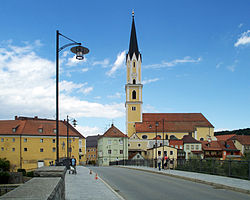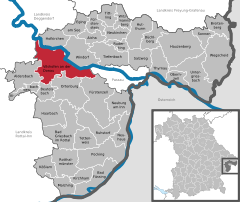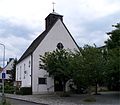You can help expand this article with text translated from the corresponding article in German. (March 2009)Click [show] for important translation instructions.
|
Vilshofen an der Donau | |
|---|---|
 Bridge over the river Vils and the parish church | |
Location of Vilshofen an der Donau within Passau district  | |
| Coordinates: 48°38′00″N13°11′14″E / 48.63333°N 13.18722°E | |
| Country | Germany |
| State | Bavaria |
| Admin. region | Niederbayern |
| District | Passau |
| Government | |
| • Mayor (2020–26) | Florian Gams [1] (SPD) |
| Area | |
• Total | 86.36 km2 (33.34 sq mi) |
| Elevation | 308 m (1,010 ft) |
| Population (2023-12-31) [2] | |
• Total | 18,061 |
| • Density | 210/km2 (540/sq mi) |
| Time zone | UTC+01:00 (CET) |
| • Summer (DST) | UTC+02:00 (CEST) |
| Postal codes | 94474 |
| Dialling codes | 08541, 08548, 08549 |
| Vehicle registration | PA |
| Website | www.vilshofen.de |
Vilshofen an der Donau is the largest city in the southeast of Bavaria, Germany in the district of Passau. Until 1972, the town was the district seat of the district of Vilshofen.






